Literature Appreciation | Stable Lithium Metal Anode Achieved via Leveraging Inevitable Stress Changes in Adaptive Piezoelectric Effect
Literature Appreciation | Stable Lithium Metal Anode Achieved via Leveraging Inevitable Stress Changes in Adaptive Piezoelectric Effect
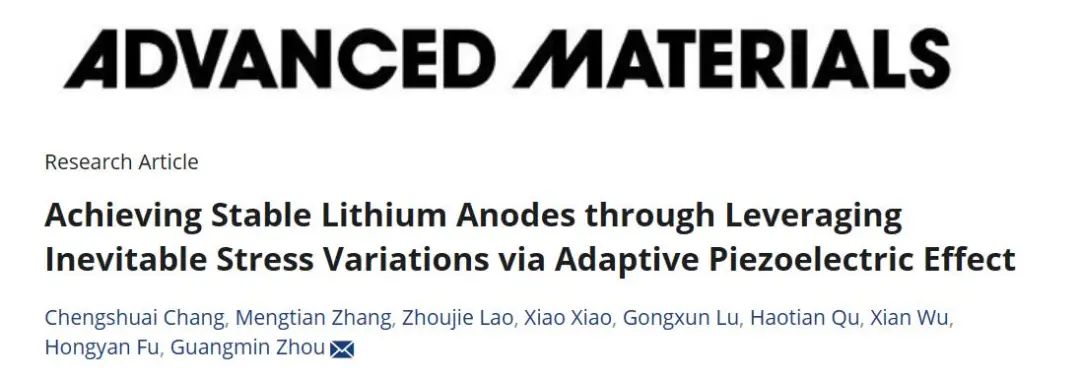
1.Article Abstract
The stress changes caused by the volume expansion of lithium metal anodes hinder the release of their full potential in practical applications, leading to problems such as electrode cracking, damage to the solid electrolyte interface, and dendrite growth. Despite various protective strategies employed to "combat" the stress on lithium metal anodes, they fail to fundamentally resolve the underlying issues. This paper proposes a unique strategy that utilizes the adaptive piezoelectric effect to convert the stress generated during battery cycling into an adaptive built-in electric field, accelerating lithium-ion migration, promoting uniform lithium deposition, and alleviating stress concentration.
Finite element simulations further validate the mechanism of piezoelectric effect modulation of electrochemical-mechanical-field evolution and decoupling. Inspired by this strategy, the feasibility is demonstrated by employing piezoelectric polymers with high sensitivity, rapid response, and certain strength of adaptability. The corresponding protected lithium metal anodes exhibit over 6000 hours of cycling stability at a current density of 10 mA/cm², extending the lifespan of various pouch and prismatic battery systems. This study effectively addresses stress-related issues, decouples the evolution of electrochemical-mechanical fields, and contributes to the development of more stable lithium anodes, thereby making a significant contribution to future research.
2.Picture and Text Appreciation
This paper combines sensing technology with finite element simulation to study the stress evolution of lithium metal anodes during battery cycling, and on-site monitoring of stress growth and distribution during battery cycling.
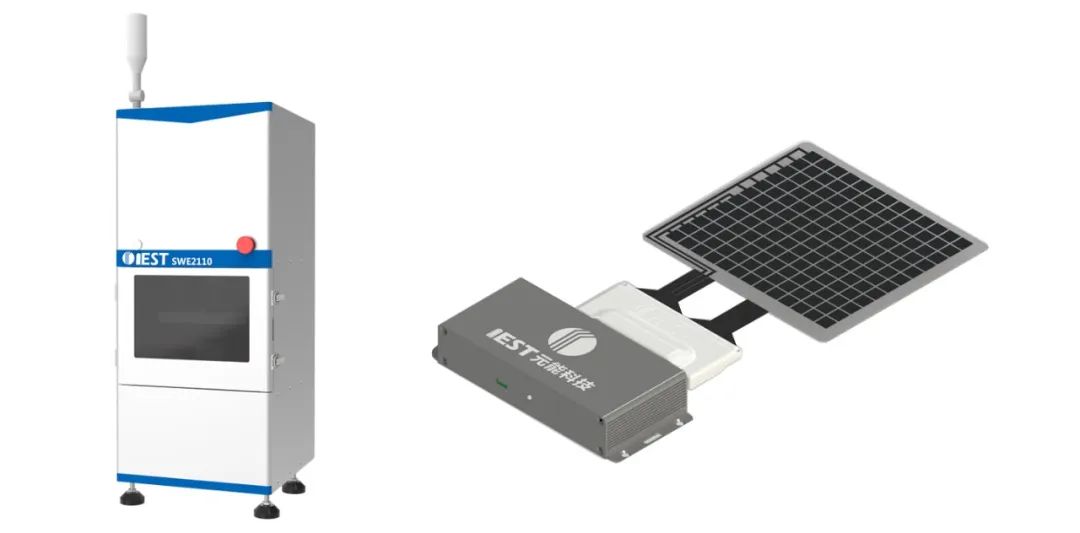
In-Situ Cell Swelling Analyzer(SWE2110)& Battery Pressure Distribution Measure System(BPD1000)
The authors utilized in-situ sensors to detect the stress variation of a 50 × 50 mm² pouch cell during cycling, which was assembled with a Bare-Li anode and an LFP cathode with nearly no volume change. This pouch cell exhibited significant stress changes during cycling, indicating substantial volume variations of the lithium metal anode during lithium deposition and stripping processes.
The pressure distribution of the Bare-Li/LFP pouch cell over several operating cycles is illustrated in the figure, showing uneven stress distribution and the formation of stress concentrations in localized areas, particularly at the TAB position. The results suggest that the pouch cell exhibits significant stress fluctuations, uneven stress distribution, and localized stress concentration phenomena. These issues gradually accumulate during cycling, ultimately leading to cell damage.
The authors propose a method to convert inherent stress variations into an internal electric field through adaptive piezoelectric effect. Utilizing finite element simulation, they elucidate in detail the modulation and evolution mechanism of the electrochemical-mechanical-field coupling relationship by the piezoelectric effect during the charging process of lithium metal anode.
During charging, the deposition of lithium ions leads to variations in the anode thickness. Additionally, the internal stress within the piezoelectric film and the magnitude of the generated electric field adaptively change with the deposition thickness during charging. It is noteworthy that areas with more lithium deposition on the anode surface spontaneously generate higher stress and adjust the electric field. This phenomenon demonstrates the adaptability of the piezoelectric film to automatically adjust the internal electric field intensity based on the amount of lithium deposition at different charge states (SOC) and different positions on the anode surface.
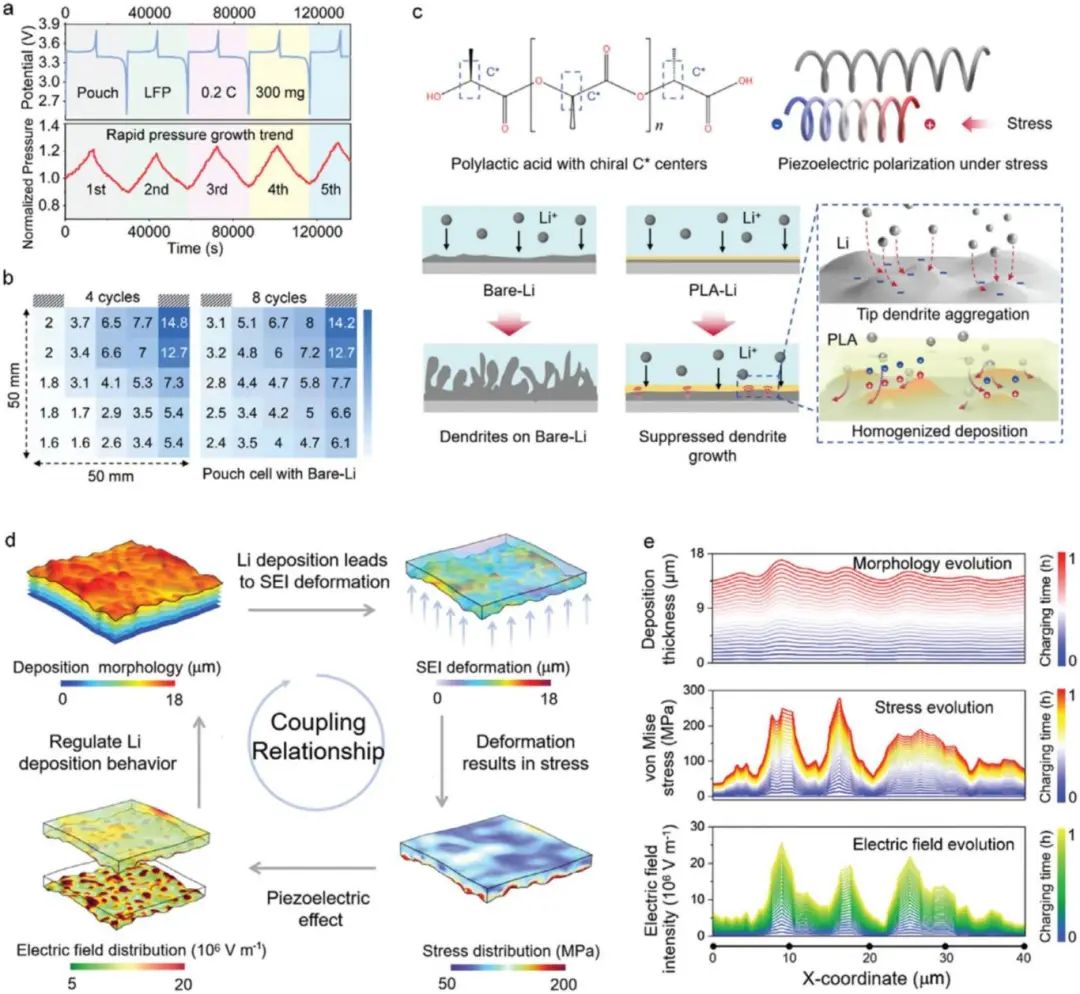

To validate the impact of piezoelectric effect and multiphysical field response, the authors prepared two polymer materials, PLA and PVDF, with piezoelectric properties for comparison. The key piezoelectric properties of PLA were comprehensively characterized using Piezoresponse Force Microscopy (PFM). The results indicated that PLA exhibited more prominent expansion and contraction vibrations within the range of 0 to 85 pm, significantly higher than PVDF (0 to 20 pm).
The higher and more uniform polarization response voltage suggests that PLA possesses superior piezoelectric performance compared to PVDF. To demonstrate and verify the electromechanical coupling effect of PLA and PVDF, as well as the strength of the inherent electric field, the potential outputs generated by the materials under varying stress were measured using a piezoelectric device. Connecting the PVDF and PLA films to an oscilloscope and subjecting them to external forces ranging from 5 to 35N, the results showed that even under minimal force (5N), the piezoelectricity of the PLA film could generate an internal electric field, indicating its high precision and sensitivity in response to pressure.
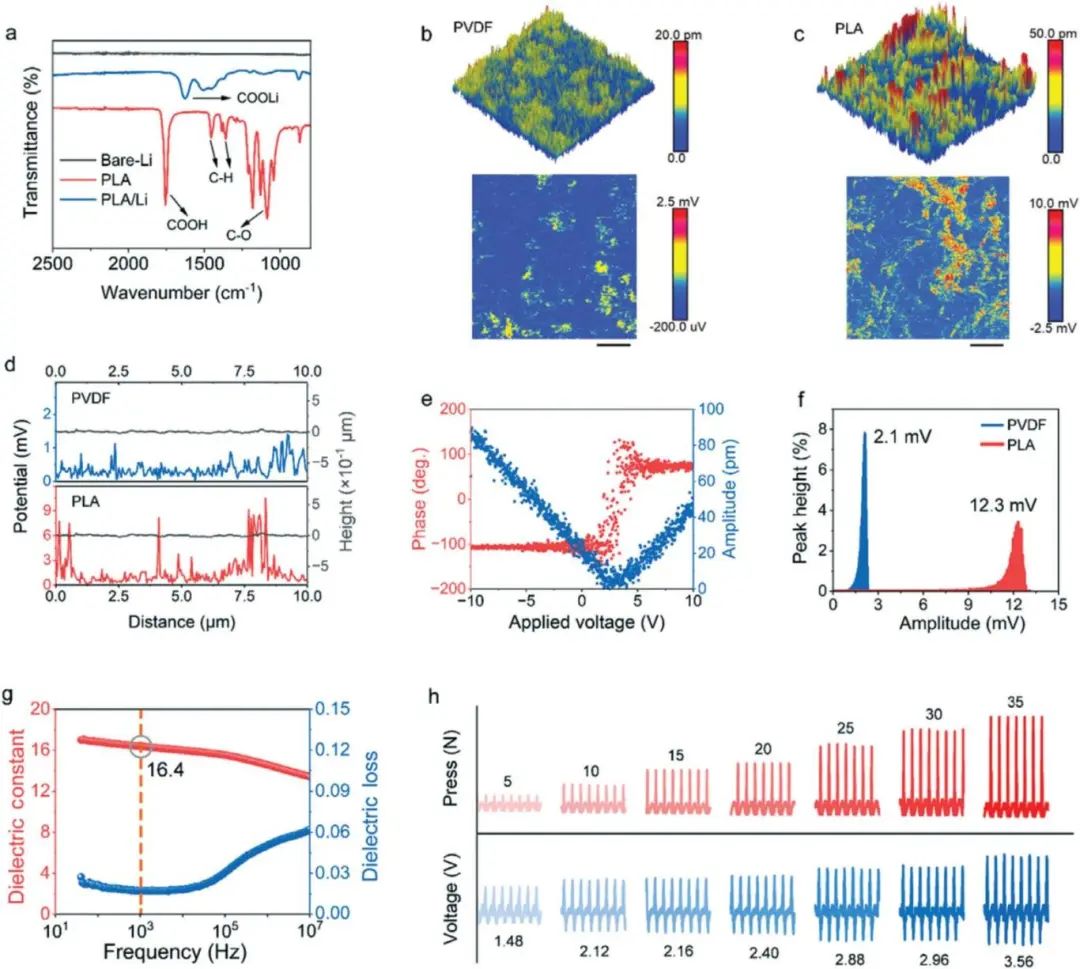

The inherent electric field exhibits a unique electromechanical coupling effect, and the authors validate its protective mechanism on LMA through a combination of theoretical simulation and experimental results. The authors employed finite element simulation to investigate the influence of the internal electric field of piezoelectric films on the electrochemical behavior of Li+ ions. Compared to Bare-Li, the Li+ ion concentration gradient within the PLA-Li film was significantly reduced, thereby weakening concentration polarization and markedly decreasing the likelihood of dendrite formation.
In addition to the concentration gradient of Li+ ions perpendicular to the anode surface typically studied, simulations of the concentration gradient within the anode surface during charging were conducted to explore the relationship between local current density and Li+ ion concentration distribution in depth. Compared to Bare-Li, there were notable differences in the Li+ ion concentration distribution on the anode surface during charging, leading to significant unevenness in the local current density distribution as depicted in the figure.
In contrast, the electric field generated internally by PLA-Li ensured that the concentration difference of Li+ ions within the anode surface remained at an extremely low level, achieving uniform distribution of local current density. These results indicate that the inherent electric field not only alleviates the concentration gradient of Li+ ions in the vertical direction but also reduces the difference in lithium-ion concentration within the plane, thereby synergistically promoting uniform distribution of local current density.
Using electrochemical impedance spectroscopy (EIS), the lithium ion exchange current of symmetric lithium/lithium batteries was analyzed. Compared to Bare-Li, PLA-Li exhibited smaller solid electrolyte interphase (SEI) resistance (RSEI) at different cycle numbers, with RSEI decreasing as the cycle number increased. Based on this, the effect of the piezoelectric effect on the morphology of the anode was analyzed using finite element analysis. After 5 cycles, the PLA-Li anode maintained a smooth and flat morphology, while the Bare-Li anode surface gradually exhibited a rough dendritic morphology during the cycling process.
The deterioration of Bare-Li morphology led to internal stress concentration in the SEI, making it prone to failure and crack formation, resulting in increased electrolyte consumption, decreased Coulombic efficiency, accumulation of "dead" lithium, and premature battery failure. Both simulation results and experimental evidence confirm the critical role of PLA in facilitating uniform deposition of Li+ ions, thereby reducing dendrite formation and improving the lifespan and safety of lithium batteries.
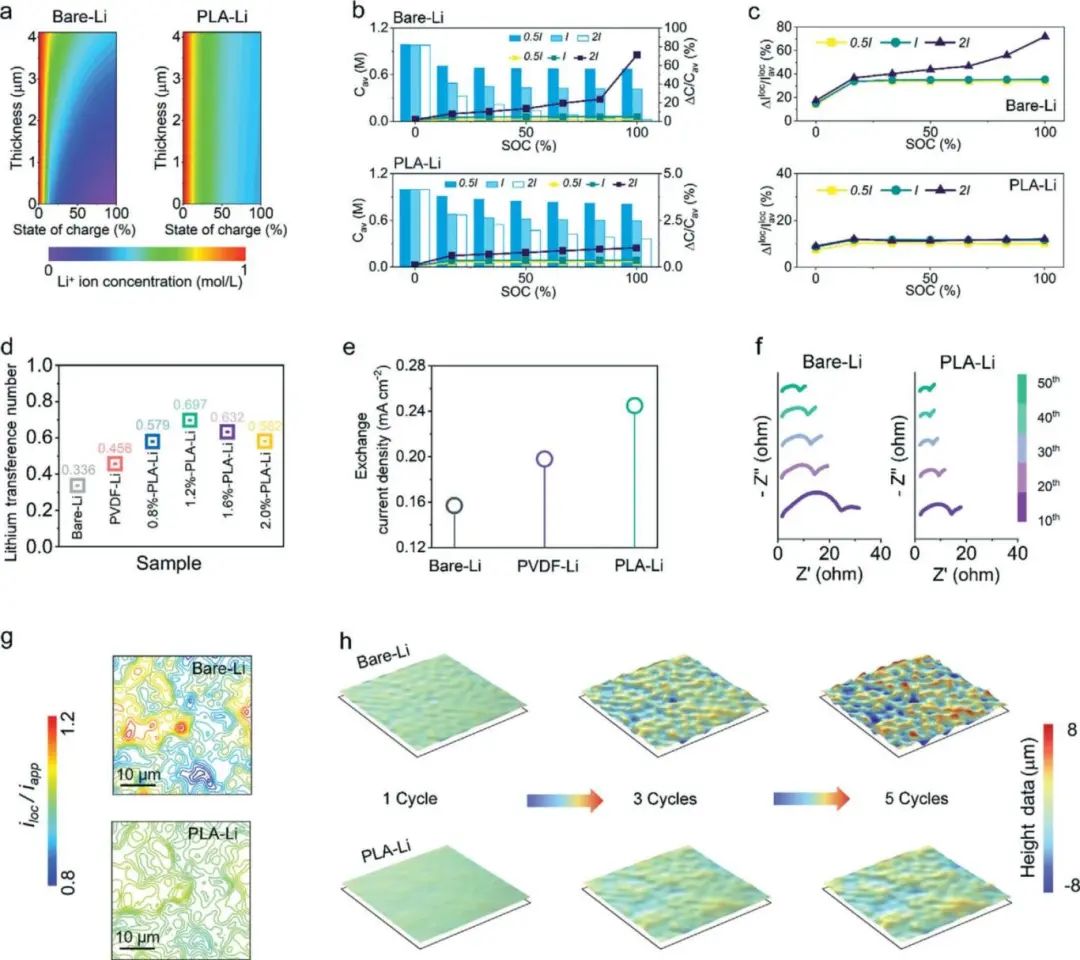

To further confirm the influence of the inherent electric field on stress modulation, we assembled lithium metal anodes into symmetric cells and evaluated their electrochemical performance. The interface stability of lithium metal anodes with Bare-Li, PVDF-Li, and PLA-Li was studied using constant current cycling of symmetric cells. The rate performance of symmetric cells was tested at current densities ranging from 1 to 5 mA/cm². As the applied current density increased, Bare-Li anodes exhibited significant voltage fluctuations, indicating the formation of severe side reactions and unstable electrode interfaces.
In contrast, the cycling stability of PLA-Li anodes was greatly improved, with negligible voltage changes. Meanwhile, the polarization voltage of PLA-Li cells was significantly lower than that of PVDF-Li cells. This finding highlights the adaptability of the internal inherent electric field of PLA, which can effectively modulate lithium deposition in response to dynamic changes in current density. It can be observed that batteries using PLA-Li anodes exhibit excellent cycling stability, exceeding 6000 hours, with polarization voltage as low as 300 mV. In comparison, the enhancement performance of PVDF coating on lithium metal anodes is limited to within 1000 hours of cycling lifespan. It can be inferred that the conversion of stress into electric field effectively enhances the electrochemical performance of lithium anodes.
Pairs of metallic lithium coated with various protective layers were paired with LFP and lithium-sulfur (Li-S) batteries to test their applicability and suitability. To study the influence of the inherent electric field on Li+ ion transport and deposition, the assembled LFP batteries were evaluated for thickness variation during cycling using an in-situ battery expansion analyzer. Due to the significant stability of the LFP electrode, the change in the entire battery thickness was attributed to deposition and stripping on the lithium metal side.
During the first five cycles of charge and discharge, Bare-Li exhibited a faster rate of thickness expansion, with an expansion of up to 0.53 × 10−2 mm after five cycles, while PLA-Li showed a slower rate of thickness expansion, at 0.31 × 10−2 mm. This reduction in volume expansion is attributed to the decrease in lithium dendrite and "dead" lithium layer thickness. Finite element simulations further verified the effective application of the piezoelectric effect in lithium-sulfur batteries. When negatively charged polysulfides shuttle to the piezoelectric film, they are repelled by the electric field force, thereby hindering their corrosion of the anode. Compared to Bare-Li, PLA-Li significantly reduced the shuttle effect of polysulfides, which is beneficial for the cycling stability of the anode and improves the utilization of the sulfur cathode.
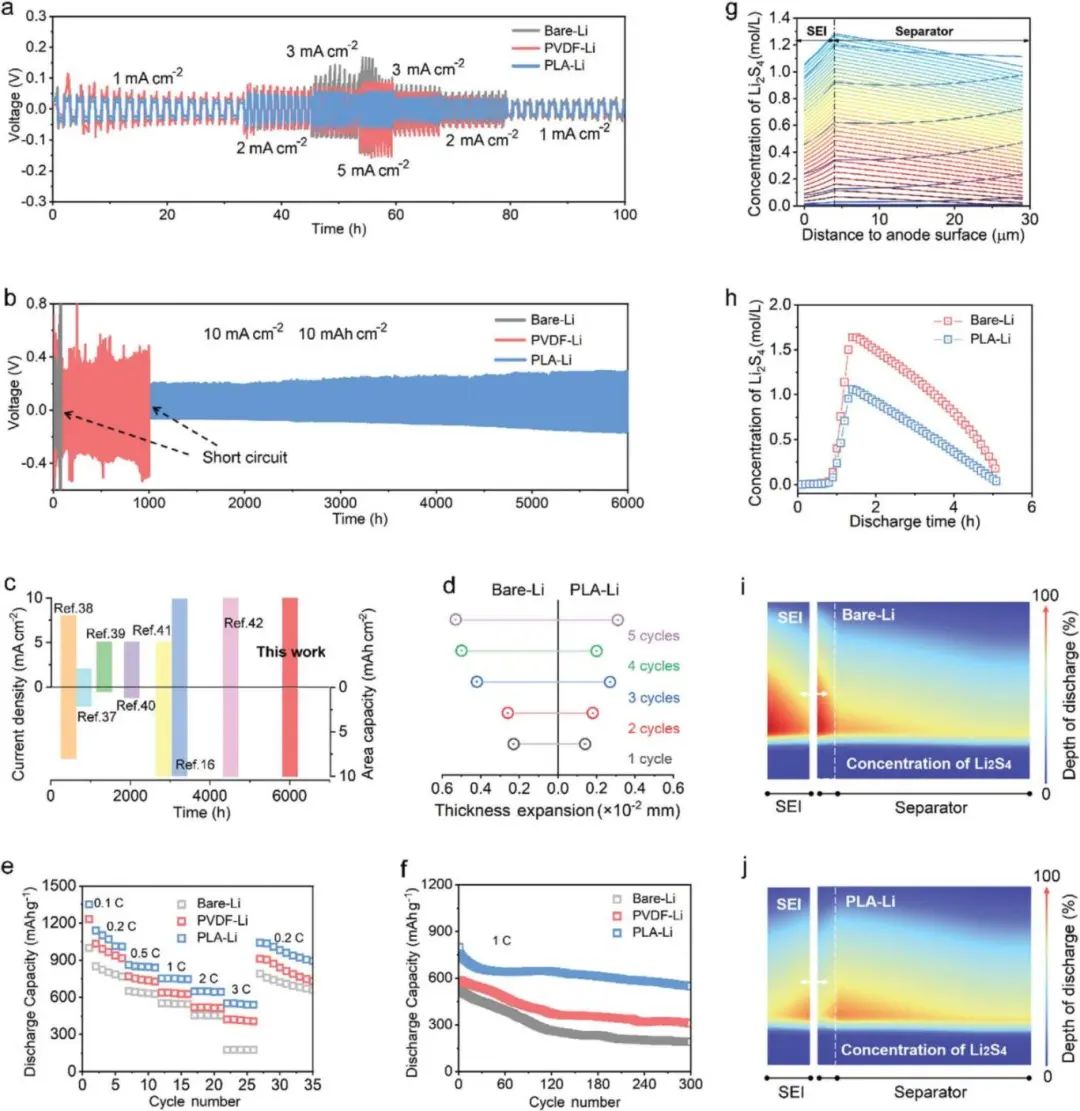

To demonstrate the practical application of PLA, which would experience more pronounced stress variations in real-world scenarios, the authors assembled a PLA-Li/LFP pouch cell with the same electrode dimensions and active material loading as the Bare-Li/LFP pouch cell. The stress changes and distribution in the protected pouch cell were studied, and a comparative analysis was conducted on the influence of the PLA protective layer on the electrochemical performance of the battery.
Compared to the Bare-Li/LFP pouch cell, the growth of expansion force per cycle is relatively slow in PLA-Li. The lithium deposition on the PLA-Li anode is very uniform, and dendritic growth behavior is suppressed. This can be attributed to the inherent electric field generated by the piezoelectric effect of the PLA layer, guiding the formation of a uniform pattern of local current density distribution.
Further explanation of the superiority of the piezoelectric effect in practical pouch cells was provided through finite element simulation. Unlike prismatic cells, pouch cells accommodate higher cathode active material loading, higher current densities, and correspondingly larger volume changes in the lithium anode. After coating the anode with a PLA film, the higher stress generated at locally deposited sites can be converted into an in-plane electric field within the anode. Therefore, the uneven distribution of local current density and deposition sites caused by variations in pouch cell size and manufacturing processes is eliminated.
This helps to achieve uniform stress distribution throughout the entire cell, avoiding the pronounced stress concentrations observed in Bare-Li. Meanwhile, during cycling, the accumulation of "dead" lithium not only gradually exacerbates the pressure throughout the entire cell but also amplifies the stress differences within the Bare-Li anode due to preferential deposition of Li+ ions. Local stress concentrations further affect subsequent Li+ ion deposition behavior, reinforcing the unevenness of local current density distribution and achieving positive feedback regulation.
This positive feedback regulation exacerbates stress-related issues, accelerating the occurrence of problems such as SEI fracture, electrode cracking, and localized dendrite growth. In contrast, PLA-Li, due to the unique protective mechanism of the piezoelectric effect, maintains a lower level of stress difference within the cell during cycling, indicating uniform lithium deposition on the anode side, ensuring the cycling stability of PLA-Li in practical pouch cells.
To validate the practical application effectiveness of the inherent electric field, the authors assembled pouch cells sized 50 × 50 mm² for Li-S and LFP batteries and observed their cycling stability. When LFP was used as the positive electrode, the capacity retention rate reached 84.7% after 100 cycles, extending the cycle life of the lithium metal battery. Moreover, the protected pouch cells successfully charged a mobile phone after cycling. In practical pouch cells, PLA improved stability and extended long-cycle life, indicating the feasibility of obtaining a stable lithium metal anode through leveraging inevitable stress changes in the adaptive piezoelectric effect.
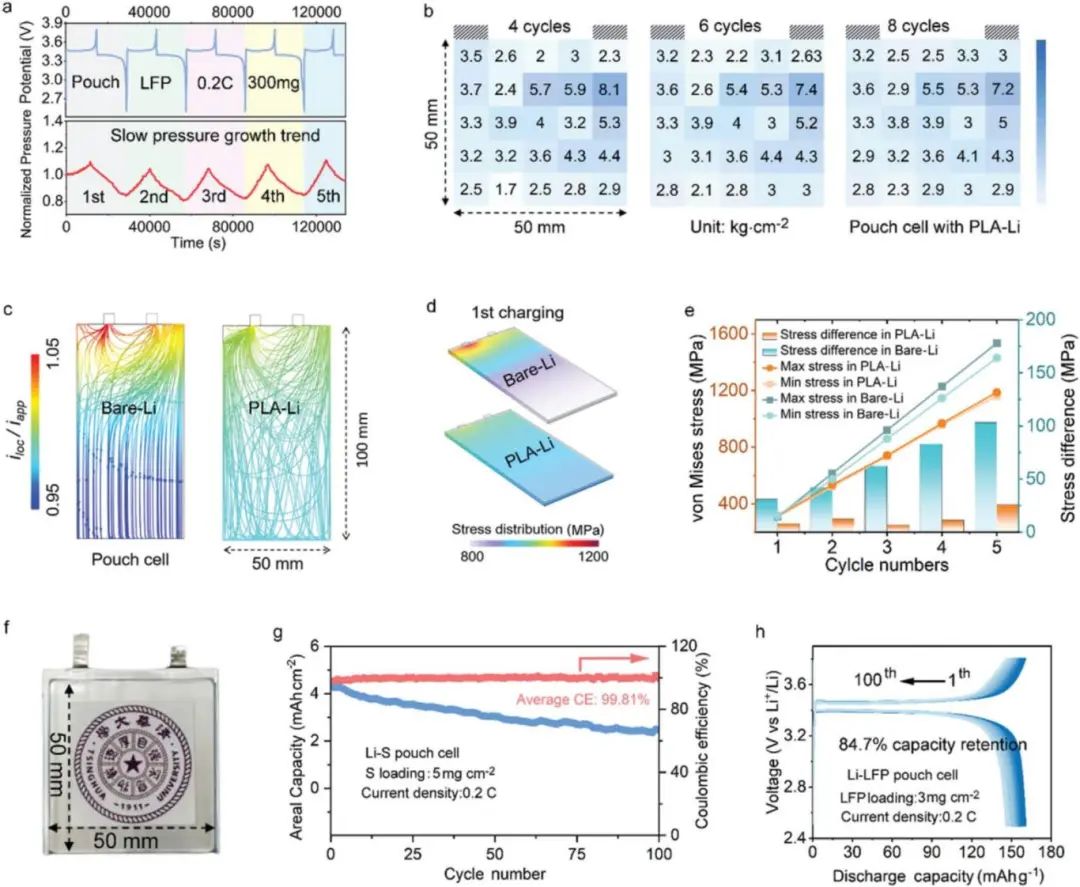

Summary
The authors proposed an innovative method to convert potential stress changes in batteries into an adaptive internal electric field through the piezoelectric effect. The electric field demonstrates the capability to autonomously adjust its intensity in response to different battery systems, enhancing not only the migration of Li+ ions but also ensuring their uniform distribution across the entire anode.
With the support of finite element simulation, the electrochemical-mechanical-field coupling relationship was revealed, selective preparation of highly responsive PLA piezoelectric coatings was achieved, and their feasibility was verified using the piezoelectric effect. Consequently, PLA effectively prevents dendrite formation, alleviates stress concentration, and ensures the long-term stability of pouch cells. We believe that the stress-adaptive approach proposed in this study will provide valuable reference for future researchers in addressing similar issues, and the integration of simulation and sensing technologies offers possible avenues for the characterization and visualization of more hidden problems associated with lithium metal anodes.
